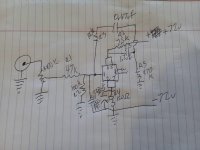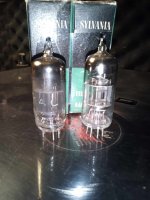The green/blk box sylvania 6ag5 with the dark carbonized glass are absolute gems in a line stage. Every time i compare it to other 6ag5, or really any other kind of tubes i have now they re-blow me away. I've been combing ebay for them for a bit now, have bought several matched pairs now too, and they are all in an entirely different league then anything else i have when it comes to soundstage presentation. even my 12ax7 circuits feel flat and dull to me now that ive gotten used to these little TV tubes. Im only running barely over 100v across the plates. They no joke feel twice as big in every direction as any other tubes i have. Some of you older tube and radio guys may have em lying around too maybe. Thats how i got my first box em them. Wish it had more of these one's though lol.
As triode > pentode as well for audio. More gain (if you need it), less THD, and a sounstagier soundstage (lol)
The linestage design im using is attached because why not. Forgot to draw the output off the coupling cap, but whatever lol.
Tube pic just to show what i mean by dark glass. They arent used. All the old green/blk box sylvania 6ag5 tv/radio tubes look like this. All have carbonized glass, but some have black plates some dont. They all sound unreal though. Some of the yellow box sylvania 6ag5 have crbonized glass, some dont, i havent tried any of them yet but have some on the way.
I'm a beginner with amp design and tubes. But i've been training an ear in the mixing and mastering side of things for quite some time, and i know an impressive soundstage when i hear it. These dark glass 6ag5 as triodes are pretty nuts. The more i learn and play with, the more i feel like i somehow lucked out and stumbled into a hidden gem right off the bat or something. Nobody uses these for anything unless they have an old radio that uses them, and most my 6ag5 are pretty nothing special tubes... But man, these dark glass tubes are a newfound love like i haven't had in audio in many years. Spec for triode class A operation is right on the data sheets for them too. When it comes to some other tubes (cough* 12ax7 cough* cough*), a set that sounds like these do is not cheap. These run about $10-15/matched pair, ive bought a few pairs on ebay already. I got a lot of 9 of them with 2 matched pairs in it for $20 shipped. The box of 6ag5 given to me free had 12 of these sylvania's in it. Won't be long and ill have enough for the rest of my days. (Maybe some of you have some and dont want them )
)
As triode > pentode as well for audio. More gain (if you need it), less THD, and a sounstagier soundstage (lol)
The linestage design im using is attached because why not. Forgot to draw the output off the coupling cap, but whatever lol.
Tube pic just to show what i mean by dark glass. They arent used. All the old green/blk box sylvania 6ag5 tv/radio tubes look like this. All have carbonized glass, but some have black plates some dont. They all sound unreal though. Some of the yellow box sylvania 6ag5 have crbonized glass, some dont, i havent tried any of them yet but have some on the way.
I'm a beginner with amp design and tubes. But i've been training an ear in the mixing and mastering side of things for quite some time, and i know an impressive soundstage when i hear it. These dark glass 6ag5 as triodes are pretty nuts. The more i learn and play with, the more i feel like i somehow lucked out and stumbled into a hidden gem right off the bat or something. Nobody uses these for anything unless they have an old radio that uses them, and most my 6ag5 are pretty nothing special tubes... But man, these dark glass tubes are a newfound love like i haven't had in audio in many years. Spec for triode class A operation is right on the data sheets for them too. When it comes to some other tubes (cough* 12ax7 cough* cough*), a set that sounds like these do is not cheap. These run about $10-15/matched pair, ive bought a few pairs on ebay already. I got a lot of 9 of them with 2 matched pairs in it for $20 shipped. The box of 6ag5 given to me free had 12 of these sylvania's in it. Won't be long and ill have enough for the rest of my days. (Maybe some of you have some and dont want them
Attachments
Last edited:
Only my view; Generally, I found Syvania video line tubes often rather noisy; partition noise in pentode & microphonic for audio. Currently, I am using the 12BY7/HG7 (have loads of them) as audio diff drivers and had to spend several evenings sorting out to get reasonably matched pairs (best set up as triodes, nice with 25dB gain). After much sorting found the Philips ECG version the most consistent performers. GE did also well, but RCA and other brands were rather noisy and microphonic. But makers for these didn´t stipulate these types to be used for audio, so didn´t strive for min noise & mictrophony in the 1950´´sand 60´s TV market, unlike the later ECC8xx series specifically for the audio market end product.. What I have found that tubes for TV (often having larger cathodes) are best run at somewhat higher currents than other types, as after several days stabilizes the characteristics.
Keep at it.....it´s all a great kudos & curiosity!
Bench Baron
Keep at it.....it´s all a great kudos & curiosity!
Bench Baron
Try http://www.mcshanedesign.net/ His contact adr is quite a long way down the page.
12BY7..........nice tube, less transconductance than the HG7. Pity that both don´t have internal shield screen.
BB
12BY7..........nice tube, less transconductance than the HG7. Pity that both don´t have internal shield screen.
BB
Im talking about a specific era of sylvania 6ag5 technically, and only certain one;s from that era. But that is still actually very true, about of the roughly 20+ of these i have and have tested now in circuit, almost all of them have huffed and puffed for the first 20ish mins ive used them. On almost all of them it goes away permanently after that first 20-30 mins period though. No idea at all what's up there, maybe there are a few gas molecules that have to get charged and thrown to the oxide layer before they perform properly. The darkglass Sylvanias are as old as 70 years at this point. I do have 3 or 4 that stayed hissing at me.Only my view; Generally, I found Syvania video line tubes often rather noisy; partition noise in pentode & microphonic for audio. Currently, I am using the 12BY7/HG7 (have loads of them) as audio diff drivers and had to spend several evenings sorting out to get reasonably matched pairs (best set up as triodes, nice with 25dB gain). After much sorting found the Philips ECG version the most consistent performers. GE did also well, but RCA and other brands were rather noisy and microphonic. But makers for these didn´t stipulate these types to be used for audio, so didn´t strive for min noise & mictrophony in the 1950´´sand 60´s TV market, unlike the later ECC8xx series specifically for the audio market end product.. What I have found that tubes for TV (often having larger cathodes) are best run at somewhat higher currents than other types, as after several days stabilizes the characteristics.
Keep at it.....it´s all a great kudos & curiosity!
Bench Baron
I also haven't been using them as pentodes, i much preferred them sonically as triodes immediately so i haven't used them much in pentode circuits. The difference between using these as pentodes vs triodes in an audio circuit is akin to pulling an invisible sheet off your speakers, so to speak. I've played with several of these sharp cutoff pentodes now, and i don't really care for any of them in an audio circuit being used as a pentode. They all sound and measure better as triodes when used for audio, but so far the dark glass sylvania 6ag5 are the only ones worth writing home about.
If you are in a noisy environment the darglass tubes def benefit from being shielded as well and youll prob toss 1 or 2 /10 for noisy heaters and 1 or 2 /10 for being huffy and puffy. But they are also incredibly inexpensive when it comes to tubes that soundstage this well, so that doesn't bother me personally.
You won't get a lot of gain from them (i think rated 36 gain as triode), but you will get a frankly ridiculous soundstage that's not quite like anything else ive heard.
Honestly i've stopped playing with my other circuits, and ive even stopped window shopping for new gear and tube types/circuits because i don't need the gain, i was just after that glowing holographic tube soundstage. These tubes are my reference when it comes to tube soundstage at this point.
Last edited:
Similiar effect.....sort of running in. one could say....I´m using the rather flightly 12HG7 as Williamson diff driver with CCS of-50V, 20mA per tube and 10K anode loads with 400V supply, that sets the anodes at approx 200V (wrt cath), a near replica of the slaughter conditions of glass TV days. As mentioned, to tame the wild pentode, the only way I found for audio was set up as triodes. Wading through the heap and set them up into rough pairs. I noticed after the hard run-in for a few days, the diff voltage stabilized. so these tubes DO require a bit of "push and shove" to stabilize their characteristics.
The unfortunate thing is, I may have culled out quite a few tubes which were quite out of any matching prospect into the "Rej" box (fortunately returned to the loft) which I thought were hopelessly gassy and noisy, but all they needed was a little time for themselves to get going..........Just like us humans !
The 12BY7 (more common) is a sim but slightly lower mu tube but maybe I should find a circuit for these gems. There does seem to be alot of tubes in the 7-12W rated anode class. Although I was brought up in the early 1960´s Uni days on tubes, I´m beginning to shun other tubes more commonly used in audio circuits as I´ve sensed better around.
On aesthestic grounds, the group of nicely glowing large cathodes does make an attraction. As a retired designer. I love the impression.
Bench Baron
The unfortunate thing is, I may have culled out quite a few tubes which were quite out of any matching prospect into the "Rej" box (fortunately returned to the loft) which I thought were hopelessly gassy and noisy, but all they needed was a little time for themselves to get going..........Just like us humans !
The 12BY7 (more common) is a sim but slightly lower mu tube but maybe I should find a circuit for these gems. There does seem to be alot of tubes in the 7-12W rated anode class. Although I was brought up in the early 1960´s Uni days on tubes, I´m beginning to shun other tubes more commonly used in audio circuits as I´ve sensed better around.
On aesthestic grounds, the group of nicely glowing large cathodes does make an attraction. As a retired designer. I love the impression.
Bench Baron

